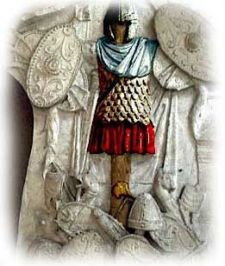 |
 |
| Home | Activity | Projects | Members | Reenactment | Media | Forum | Links | Contact |
|---|
 |
|---|
 ::Reenactment resources::
::Reenactment resources::
 |
|---|
|
Pieces of Military Equipment We list here all items part of a warrior’s equipment which are not weapons per se. Helmets. An analysis of sculptures and archaeological finds indicates that helmets were not widely used among the Dacians. Still, they were found in some tumuli tombs dated to the time of king Burebista. Later on they almost ceased to be used, in order to reappear on Trajan’s Column, 150 years later. On this monument, several helmets are depicted on the basis of the column, but nowhere else. The objects have curved upper ends and thus remind the pileus caps worn by the Dacian nobles. Leather helmets might have also been used, compensating for the absence of those made of metal. Mail shirts. The first mail shirts appeared in the Carpathian area with the Celts. They were among the most expensive types of defensive military pieces of equipment, but were in the same time elements of prestige, indicating the noble rank of the warriors wearing them. Mail shirts were composed of rings measuring between 0.8 – 0.9 cm and 1.2 – 1.4 cm in diameter. Armor. Armor was part of the protective equipment of the heavy cavalry. It consisted of metal shirts for riders and sometimes protective covers for the horses, made of bronze and iron plaques (segments). Some scenes on the Column seem to depict such military Dacian units. No doubt, they took the model from the Sarmatians who used this type of metal segments. Such objects were rarely discovered on Dacian sites, but it is important to note that they are not completely missing. Metal armor segments measure between 2.5 and 3.5 cm in length and 1 – 1.5 cm in width. Their shape varies according to the preference of the buyer: oval with flat top (with two or four orifices), rectangular (with two fixing orifices placed vertically, on the upper and lower end). One cannot exclude the existence of leather cuirasses which were used by all neighboring populations, including the Romans. An antique source, Dion Chrysostomos, clearly mentions the items when writing: “There, among them…one could see everywhere swords, cuirasses, lances…” Spurs are part of the equipment used by fighters on horseback. All discovered items are made of iron, with a diameter between 0.5 and 0.6 cm, and are circular or semicircular in section. Dacians used two types of spurs: small ones with flat sides, ending in massive buttons and long sharp spike and large ones with high sides, ending in flat or thick oval buttons, with long and sharp spike. Buckles were part of both civilian and military dress. They were made of iron and their frames came in various shapes: circular, D-shaped (made of a single metal piece), rectangular (some even made of bronze), oval, or 8-shaped. Buckles measured between 3 and 5.5 cm. Belt buckle terminal rings were made of a ring with side elements resembling claws which frame a simple pin ending in shape of a circle. Some are made of bronze and they reach 5.5 – 6.1 cm in length. The belts were fixed through a hook introduced in the terminal ring or circle. Belts with astragal decorations were found on few sites on the territory of pre-Roman Dacia. They were belts made of iron or bronze used for the hanging of swords. They appeared during the fifth century B.C. in the Illyrian area and were then spread by the Scordiscian Celts in the Carpathian basin. Archaeologists usually discovered isolated belt fragments (astragals). |
|---|
2008 Copyright | All rights reserved Terra Dacica Aeterna |
